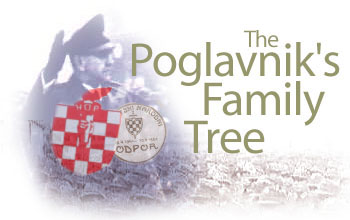FIFTY-FOUR YEARS AGO, THE poglavnik, or fuehrer of the Nazi puppet state of Croatia, Ante Pavelic, arrived in Buenos Aires, into the welcoming arms of the Peronistas and a large contingent of his former underlings. Though he was a wanted man for war crimes and atrocities carried out on his orders in the Independent State of Croatia (Nezavisna Drzava Hrvatske, or NDH), Pavelic had eluded arrest for more than three years with the assistance of a network of Catholic priests dedicated to preserving the remnants of Hitler's New Order, with the approval and often collaboration of the British and American authorities.
Pavelic was one of the last but most important leaders of the NDH to arrive in a country which was already achieving notoriety as a safe-haven for Nazi fugitives. Other Ustase officials had escaped to Spain and Portugal; more would travel onward to democratic countries such as Sweden, Norway, Australia, Canada and the United States. They brought with them the kernels of a new movement and the tacit blessing of several Allied intelligence agencies who saw the blood-covered Ustase as useful tools in the coming war against Communism.
The ideological base of the Ustase exiles was unchanged from what it had been before the war: virulent anti-Semitism surpassed only by their anti-Serbianism, and the celebration of a personality cult dedicated to Pavelic and a select group of "martyrs," which no living Croat could penetrate. Though the rhetoric of the more loquacious Ustase spokesman would give the movement a varnish of democratic and pro-Western appeal, a quick perusal of any of the literature or statements they later produced indicates that the Ustase movement in exile retained it's neo-fascistic core, lacking the dullest gleam of self-examination or repentance.
Unlike many other exile movements which formed as the Iron Curtain descended across Eastern Europe, the NDH fugitives could look within the Ustase's own history for a model of organization and tactics as an exile movement. The Ustase had been an exile movement before the war, operating training camps for assassins and terrorists to be unleashed on the Royal Yugoslav government under the House of Karadjordjevic. Indeed, as their catastrophic recklessness and mismanagement of the NDH illustrates, Pavelic and the Ustase were far better suited plotting and conspiring on the fringe of the political landscape than coping with the day-to-day banalities of statecraft. The return to their roots as an exiled terrorist organization was a natural succession, and a comparatively easy one as nearly all of the political organizers and ideologists of the movement had by hook or crook evaded arrest when Hitler's European satellites collapsed with the Third Reich. (more...)
The Poglavnik's Family Tree: Unraveling the Ustase Successor Organizations

No comments:
Post a Comment